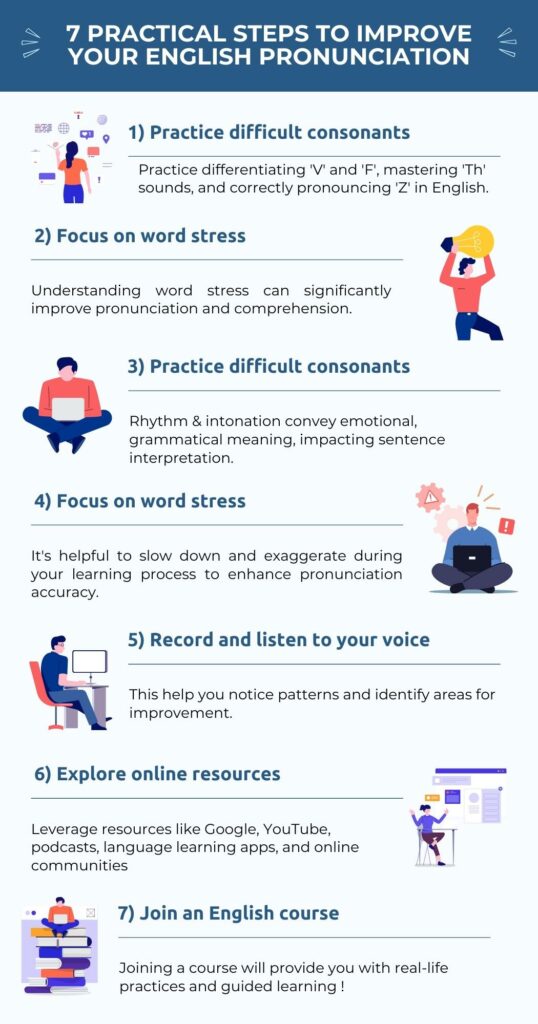
7 practical steps to improve your English pronunciation
Welcome back, English learners!
Today, we are going to talk about English pronunciation!
Let’s be honest, sometimes English pronunciation can be a bit… wacky.
It’s a land filled with silent letters, words that look the same but sound different, and sounds that look impossible to make. (Yes, ‘th’, we’re looking at you.)
But, let’s face it, good pronunciation is important. It’s the bridge between individual words and fluent speech, and it helps us communicate clearly and confidently. Poor pronunciation, on the other hand, can lead to misunderstandings and confusion.
But fear not! While the path to perfect pronunciation may seem strewn with irregular verbs and tricky phonemes, it’s also an exciting journey that will lead you to improved communication skills and a deeper understanding of the English language
So buckle up, take a deep breath, and let’s dive into the fascinating world of English pronunciation. Trust us, it’s going to be one heck of a ride!

1. Practice difficult consonants
Here’s the deal: Bahasa Indonesia is like that easygoing friend we all have, the one who likes to keep things simple. The language has a straightforward, phonetic spelling system, which is great for learners, but it also means that some English consonants can seem like they’re playing hard to get.
So, here are some things to keep in mind:
– The ‘V’ and ‘F’ sounds
In Indonesian, there’s no distinction between the ‘v’ and ‘f’ sounds, which can lead to some funny mix-ups in English. Practice makes perfect, though. Try saying words like ‘vase’ and ‘face’ and feel the difference in your mouth. For ‘v’, your top teeth should touch your bottom lip.
– The ‘Th’ sounds
Ah, the notorious ‘th’ sound! In English, ‘th’ actually represents two sounds – the voiced sound as in ‘this’, where your vocal cords vibrate, and the unvoiced sound as in ‘thing’, where they do not. To make these sounds, put your tongue between your teeth and blow air out (for ‘thing’) or do the same while also using your voice (for ‘this’). This might feel a bit weird at first, but with practice, you’ll get the hang of it.
– The ‘Z’ sounds
This one doesn’t exist in Indonesian, and it often gets replaced with an ‘s’ sound. But in English, ‘z’ is everywhere, hiding in words like ‘zebra’ and ‘buzz’. To make the ‘z’ sound, your tongue should be behind your teeth, and your mouth a bit open. Practice with words like ‘zoo’, ‘zero’, and ‘zip’.
All these new sounds might feel strange at first, but that’s just because your mouth isn’t used to making them. Keep practicing and before long, these tricky English consonants will feel more natural to say.
2. Focus on word stress
Ready for the next step on our pronunciation adventure? Excellent! Let’s talk about word stress, a key element in English that often likes to play hide and seek with Indonesian speakers.
In Bahasa Indonesia, word stress (emphasis on a particular syllable in a word) is like that quiet guest at a party, barely noticeable. But in English? Word stress struts around like it owns the place. It can change the meaning of a word (like ‘con-TENT’ the noun versus ‘CON-tent’ the adjective) and can be the difference between sounding like a ‘just-started-learning’ speaker and a ‘been-speaking-for-years’ speaker. Intriguing, isn’t it?
Here’s the good news: Although English can sometimes feel like a rule-breaking rebel, there are some patterns. For example, two-syllable nouns often have the stress on the first syllable, like ‘TA-ble’, while two-syllable verbs have the stress on the second, like ‘re-LAX’. But remember, English loves its exceptions!
You can use tongue twisters to practice identifying and pronouncing these word stress. For instance, try saying “Which WITCH is which?” or “Peter Piper picked a peck of PICKled peppers.”
Don’t hesitate to sing as well! English songs can help you get a feel for the rhythm and stress patterns of the language. Plus, it’s a lot of fun!
3. Explore rhythm and intonation
Rhythm in English is about the pattern of stressed (strong) and unstressed (weak) syllables, creating a kind of linguistic beat. On the other hand, intonation, or the melody of English, refers to the ups and downs in pitch that carry emotional and grammatical meaning.
The same sentence can have different meanings depending on the intonation. For instance, the sentence “You’re going?” can be a surprise, a question, or a statement, depending on how your voice rises and falls.
4. Slow down and exaggerate
Yes, you heard it right – sometimes, to make progress, we need to slow down, and to sound more natural, we need to exaggerate. This might sound counterintuitive, but trust me, it works wonders.
Slowing down and exaggerating in English language learning might seem like an unusual strategy, but it’s more beneficial than you might think. In our efforts to become fluent, we often rush, aiming to keep pace with native speakers. However, this rush can blur our pronunciation, causing mispronunciations, skipped sounds, and a rhythm that’s off-beat.
Instead, by slowing down, you allow yourself the space to clearly articulate each sound, each syllable. It’s like taking a leisurely walk instead of a hurried run—you get to appreciate the scenery, understand the layout, and gradually, you build the stamina to pick up the pace while maintaining accuracy.
Now, let’s talk about exaggeration. You see, English is a dramatic language, full of ups and downs, twists and turns. It’s like a rollercoaster, while many other languages (including Bahasa Indonesia) are more like a scenic train ride – smoother and more even. Exaggerating the intonation, stress, and even individual sounds of English can help you capture this sing song-like quality.
Over time, you’ll start to understand these nuances, and you can gradually readjust the level of pace and exaggeration until you reach a balance that is both comfortable for you and clear to listeners.
5. Record yourself and listen to your voice
I know this can be very daunting. To be honest, I really hate listening to my recorded voice. It sounds foreign and I can’t believe that’s how other people hear my voice. But trust me, this will be worth it!
Start by finding a good recording app. Virtually every smartphones come with built-in voice recorders, but there are also plenty of free apps available that offer additional features like high-quality recording and easy playback.
Next, you’ll want to choose a short text to read aloud. It could be a dialogue from your favorite movie, a paragraph from an interesting book, or even lyrics from a catchy song. The key is to pick something that is at your English level and includes some sounds or intonations you find challenging.
Before you hit the record button, take some time to practice. Read through the text a few times, getting comfortable with the flow of words and the rhythm of the sentences.
Now it’s time for the main event – recording. This is your moment to shine, so try to relax and speak naturally. It’s important to remember that this is not a performance, but rather a tool for learning and improvement.
Once you’ve finished recording, play it back and listen carefully. Listen for the pronunciation of each word, the rhythm of your speech, and the intonation. Are there any sounds you’re having trouble with? Any words that didn’t come out quite right?
If you have an audio recording of a native speaker reading the same text (perhaps from an audiobook or movie clip), compare your recording to theirs. This comparison can provide valuable insights into the differences and areas you can work on.
Making this a regular part of your English practice can yield significant improvements over time. You’ll start noticing patterns, understanding your strengths and weaknesses, and slowly but surely, your pronunciation will begin to improve!
6. Explore online resources
In today’s digital age, the world is quite literally at our fingertips, and learning English is no exception!
The easiest to dip into is Google – when you look up a definition of a word, it will also tell you how to pronounce it.
Video-sharing platforms like YouTube have countless tutorials that focus on specific pronunciation challenges. You can find videos that breakdown sounds, demonstrate mouth and tongue positions, and even give you words and sentences to practice with.
Language learning apps can be another great tool. Many of them offer interactive pronunciation exercises with instant feedback, allowing you to practice and improve at your own pace.
Don’t forget about podcasts and audiobooks. These can be excellent for tuning into the rhythm and intonation of English, especially if they’re aimed at language learners or come with transcripts.
Online communities are also a fantastic resource. Forums, language exchange websites, and even social media groups can connect you with native speakers and fellow learners. You can ask questions, share resources, and even find language partners for practice!
7. Seek language exchange partner or join an English course
While self-study and online resources are fantastic, there’s just no substitute for connecting with real people who share your passion for language learning!
Language exchange partners are an excellent way to practice your English pronunciation in a safe and supportive environment. By connecting with someone who’s learning your native language (Indonesian, for example), you can create a mutually beneficial learning experience. You’ll practice English while helping your partner practice Indonesian.
Many websites and apps are available to help you find the perfect language exchange partner. You can search for partners based on their native language, interests, and availability. These platforms often provide tools for messaging, voice calls, or video chats, making it easy to practice your pronunciation together.
Alternatively, signing up for an English course can also be a powerful step in your language learning journey. These courses offer structured learning pathways and the guidance of skilled educators who can pinpoint and help overcome your specific pronunciation hurdles. The interactive environment of a classroom provides ample opportunities for practical conversation, group activities, and personalized feedback.
Furthermore, attending an English course can help you stay motivated and disciplined in your language learning journey. The structured learning environment and group dynamics can encourage you to keep practicing and improving.
Summary
Whether you choose to seek a language exchange partner or join an English course, the key is to immerse yourself in real-life conversations and practice opportunities. This will not only help you fine-tune your pronunciation but also allow you to build confidence and make new friends along the way!
Do you want to speak English with confidence?
Most people lack confidence when they speak English. They are afraid to make mistakes and are embarrassed to speak in front of others.
This is because they have been taught English the wrong way!
Most English courses waste your time and money on useless exercises that don’t bring results. Even worse, they teach you bad habits that are very difficult to unlearn.
As a result, you become confused and lack confidence. This is wrong!
#1 English course in Indonesia
Our goal is to get you speaking in English with fluency and confidence as fast as possible. We want to give you the skills you need to fulfil your potential!
Our experienced teachers will guide you along every step of the learning process to ensure that you are not wasting your time, money, and energy on useless language exercises & wrong methods.
Our course
With our modern campus and technology, we are equipped to provide the best possible courses for children, teens, and adults, including:
